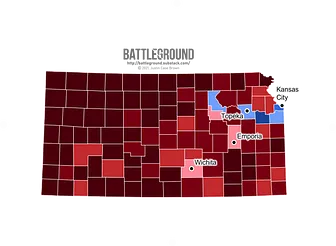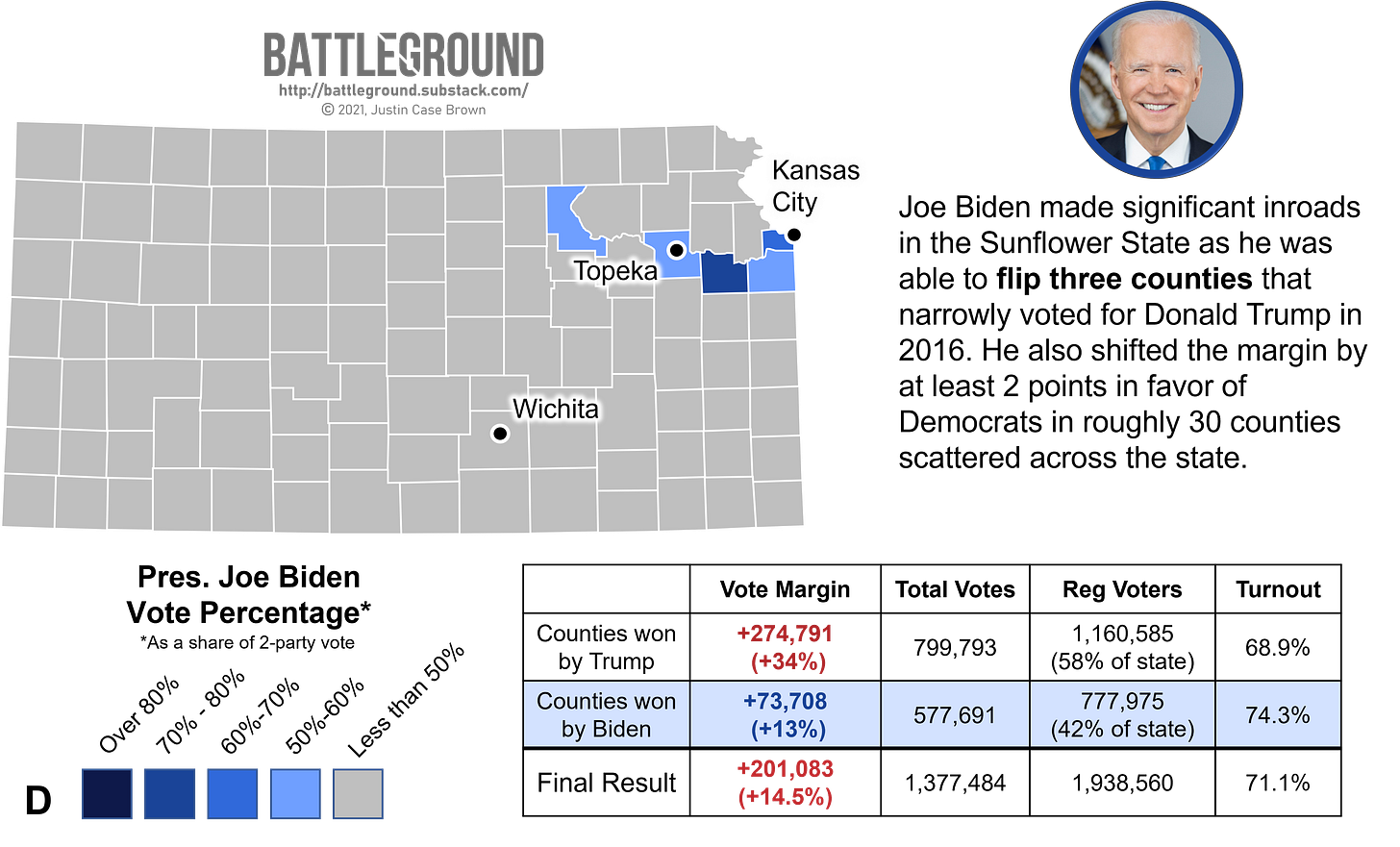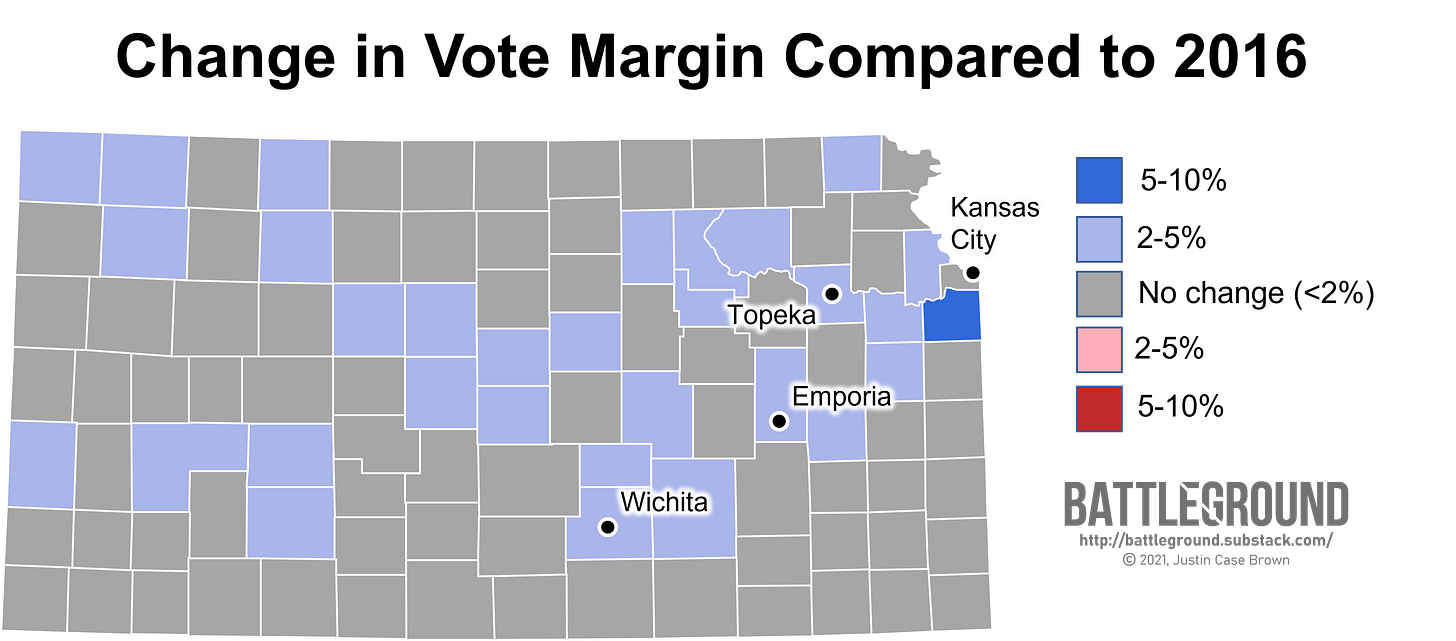Kansas: The Next Swing State?
Let's take a deeper look at Kansas's history following its vote on abortion.
You may have heard that voters in Kansas rejected a proposed state constitutional amendment that would have said there was no right to an abortion in the state. With all eyes on Kansas, some historical context can help make sense of how we got here.
The following post was originally written in late September 2021. It reviews results from Kansas’s 2020 presidential vote and shows some of the political history that led to the recent vote on abortion. Kansas certainly isn’t flipping to Democrats anytime soon on the presidential level but the Republican party is failing to pull the state to the right.
Topline Takeaways
Republicans have dominated Kansas on the presidential level for decades. The last time the state voted for a Democratic presidential candidate was in 1964.
Despite most of its land area being sparsely populated, Kansas is urbanizing quickly as its top 5 most populous counties are among the only ones seeing consistent population growth.
Moderate Republicans in Kansas are growing increasingly unhappy with their party, opening a rift that may allow moderate Democrats to squeeze through.
In-Depth Insights
Kansas has long been a Republican stronghold in presidential politics. Despite occasionally flirting with Democratic candidates for statewide offices, Kansas has picked the Republican nominee in every election dating back to 1964. Donald Trump’s base of support was strongest in the rural western reaches of the state where many counties gave him as much as 90% of their votes. He also held onto slim winning margins in some of the state’s cities including Wichita, the state’s most populous. Kansas holds a strain of conservatism that dates back to FDR and the New Deal and recent far-right policy initiatives have led many voters to question their commitment to the Republican party.
In 2012, the state embarked on what many later called the “Kansas Experiment.” Kansas Republicans passed the largest income tax cut in the state’s history with the goal of sparking economic growth. At the time, Republican Gov. Sam Brownback touted that the cuts would be “like a shot of adrenaline into the heart of the Kansas economy.” Five years later, the experiment was widely condemned as a failure as the state lagged behind neighboring states in economic development and experienced a massive budget shortfall of hundreds of millions of dollars. The experiment ultimately hurt local Republicans as they were forced to make drastic cuts in education to balance the budget. Cuts were so steep that the Kansas Supreme Court had to step in: ruling that the state’s education spending was unconstitutionally low. It also opened a rift between the moderate and conservative wings in the party which ultimately led to the election of the current Democratic governor Laura Kelly.
Joe Biden made significant inroads for Democrats in Kansas, scoring the highest percentage vote for a Democratic presidential candidate since Michael Dukakis in 1988. He flipped three counties that Trump had won in 2016, two of which (Johnson and Riley counties) had never previously voted for a Democratic presidential candidate. Biden also increased Democratic margins in many of the state’s western counties that voted overwhelmingly for Trump. Together these gains are important in a state where the urban-rural divide is deep. More than half of the state’s total vote in 2020 came from it’s top 5 most populous counties. Joe Biden brought four of those five to Democrats with the final holdout being Sedgewick county, home to Wichita.
Forecasting the Future: Kansas is urbanizing at a surprising pace. While most of its land area is sparsely populated, the state’s few urbanized counties are among the only ones seeing population growth. More than 90 counties in Kansas saw population declines between 2010 and 2020, nearly all of them won by Trump. Meanwhile the state’s most populous county, Johnson (south of Kansas City) saw an 11% increase in its population and flipped to Democrats. Republicans will be forced to increase their campaign efforts in the state’s cities to remain competitive due to the declining voting power of the large swath of rural counties in the west.
Even worse for Republicans, Kansas lands in the top 20 states in the nation for its proportion of residents with a bachelors degree. Kansas is a political outlier in this group as every other state in the top 20 (except for Utah) reliably supports Democratic presidential candidates. Higher rates of educational attainment may help explain why some Kansas Republicans have resisted the national party’s pull to the right.
Democrats path to a presidential win in Kansas is narrow but not impossible, as evidenced by Laura Kelly’s 5-point win in 2018. While the state’s electorate remains more conservative than liberal, voters are willing to entertain Democratic candidates if Republicans nominate politicians that stray too far to the right. A blue wave likely isn’t on the horizon for Kansas but the state’s deep-red hue may soon turn into a more complex shade of purple.






